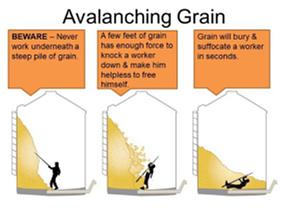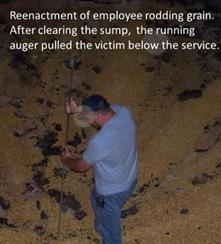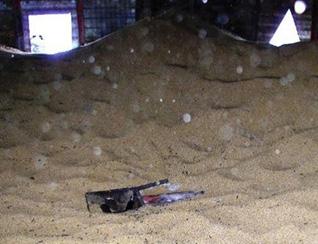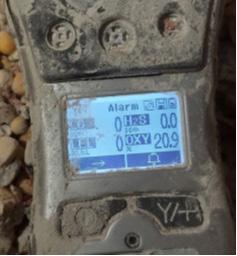7 minute read
Grain Entrapment/Engulfment
By Jim Nolte, WABA Safety Director
Reprinted with permission from Grain & Feed Association of Illinois
Grain entrapment/engulfment has always been one of the top six big hazards in the grain industry. Unfortunately too many incidents are still happening. According to the Purdue University 2020 Agriculture Confined Space Accident Summary, 20 fatal and 15 non-fatal grain engulfment farm and commercial incidents were reported in 2020--a 7.9% decrease from 2019.

Case Study #1: Evaluate Grain Bin Entries
An employee was inside trying to unplug a reclaim sump hole. All unloading equipment was locked out and de-energized. The sump hole was the second one from the wall of the bin. It was assumed there was an out-ofcondition chunk of grain plugging the sump hole. The employee had a rod and attempted to poke in the general area of the sump hole, and the grain along the wall broke free and avalanched onto him. It knocked him off his feet and pushed him several feet away. Luckily, he was not completely engulfed and was rescued by co-workers. The victim stated he was amazed how fast the grain moved upon him and there was no time to the get out of the way. During the permit process, an evaluation of the grain condition must not have been completed. The angle of repose of the grain had to be too steep. All entries into grain bins must be evaluated before and during the entry process. Grain “towers or pyramids” could be uncovered. Also, atmosphere issues could arise.
Case Study #2: Grain Vac Safety
The employee was using a grain vac to empty a grain bin to repair a malfunctioning reclaim conveyor. The bin had 250,000 bushel capacity. An estimated 30,000 to 40,000 bushels of grain remained in the bin at the time of the accident. The employee had 11 years of experience operating grain vacs and was left alone at the time of the accident. The company’s procedure was to keep the intake nozzle inserted in the grain at a shallow angle and frequently move it to different locations in the bin to keep the grain surface even. A second employee went to the bin to relieve the grain vac operator and could not locate him. Rescue workers were called and they found the grain vac operator three feet under the grain surface lying in a horizontal position a few feet from the vacuum tube, with his feet pointed towards the tube. The vacuum had been in this location long enough to create a coned-down depression of grain. Rescue workers cut a hole in the bin to draw the grain away from him. It took them 50 minutes to retrieve the man who was dead.



An employee was working alone unloading a grain bin (loading trucks). The bin had 50,000 bushel capacity. An estimated 15,000 bushels of grain remained in the bin at the time of the accident. The grain quit flowing because soybean pods (or chunked grain) had plugged the sump hole. This bin had no tunnel to rod from underneath, so the employee entered with a rod through a side door to unplug the sump hole. He did not notify anyone of the situation. The reclaim conveyor was still running as the employee entered the bin. While standing above the sump hole, the employee “rodded” the plug free and became trapped in the flowing soybeans as the grain began to flow again. The grain was deep enough to totally bury the employee. Luckily, he placed his hat over his mouth and nose to keep grain out of his airways, but his foot became entangled in the reclaim auger. After his foot became entangled, the auger stopped. The victim was found after about 45 minutes and rescue services were called. Rescue workers cut holes in the bin to free the man of the soybeans. After five hours, the man was finally freed from the auger by amputating his leg below the knee. He survived the engulfment and the amputation, but unfortunately he died five weeks after the accident due to complications. Please follow safe grain storage structure entry procedures required in OSHA 1910.272. Above all else, always evaluate the condition of the grain before and during entry.
Provide Training
Companies are required under the grain handling standard to provide training to employees on the specific procedures and safety practices for entering and working in grain storage structures. The training should include at a minimum: • Engulfment hazards associated with entering and working and how to avoid them (i.e. flowing grain, bridging, out-of-condition grain). • Lockout procedures specific for each piece of equipment. • Proper use of a 4 gas meter or procedures for ventilating to alleviate oxygen deficient atmospheres/toxic atmospheres or proper use of a respirator. • How and when to use a full body harness and lifeline; provide equipment for rescue operations which is specifically suited for the bin, silo, or tank being entered. • Rescue procedures and how to obtain additional help in emergencies. • How communication will be implemented (between employees entering and the observer) while working in the storage structure.
• Informing employee of general unsafe work practices that are prohibited, such as walking down grain, standing on moving grain, or entering under bridging or avalanche conditions.
Issue a Permit


Employers are required to issue a permit which certifies that bin-entry precautions have been implemented. These precautions include locking out the unload system, testing or ventilating the air in the bin, providing a lifeline and a full body harness, and making sure the observer is in place.
Lockout All Unloading Equipment
This safety precaution is required to prevent the unexpected start-up of equipment when someone is inside the structure. Lockout includes all equipment such as conveyors as well as gravity gates.
The atmosphere inside a storage structure is required to be tested if it is suspected that combustible gases, vapors, or toxic agents are present. Also, the structure must be tested for oxygen content unless there is continuous natural air movement or forced ventilation (i.e. ventilation fans) before and during the entry. If ventilation cannot remove the toxic atmosphere or low oxygen content, then a respirator must be used.
Wear Protective Equipment
Employees are required to be equipped with a full body harness and lifeline or boatswain’s chair whenever entering from a point that is higher than the grain (i.e. entering from above) or when an employee walks on grain that is deep enough to cause an engulfment hazard. OSHA requires that the lifeline be positioned so that it would prevent the employee from sinking further than waist deep in the grain. OSHA states that a lifeline/ harness is not needed if the employer can demonstrate that it is not feasible or creates a greater hazard than one posed by engulfment. The employer is then required to provide an alternative means of protection to prevent employees from sinking further than waist deep in the grain.
Provide an Observer
Bin entry requires at least two people (one inside and one outside). The observer must be equipped to provide assistance and must maintain visual, voice or radio contact at all times during the entry. The observer must also be trained in rescue procedures including procedures for summoning help. Note: Observers must be trained not to immediately rush in to save someone because this could cause more problems than solutions.
Flat Storage Buildings
Flat storage buildings are under the same requirements as grain storage structures when employees will be standing on grain deep enough to cause an engulfment hazard. (See above “Wear Protective Equipment” for specifics.) If entry is made at ground level through the walk-in doors and employee will not be walking on the grain, no permit is required. OSHA states that in flats, “No employee shall be permitted to be either underneath a bridging condition, or in any other location where an accumulation of grain on the sides or elsewhere could fall and engulf that employee.”
Please follow these entry rules and remember… engulfment can happen to any employee regardless of experience!



